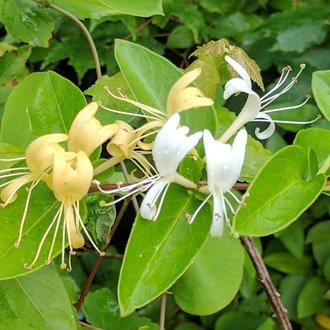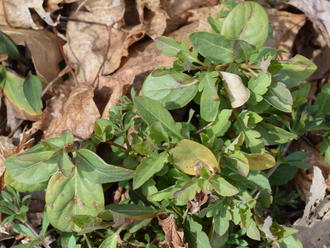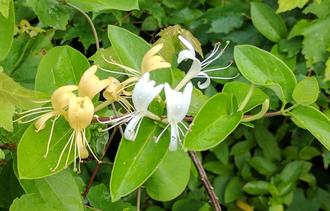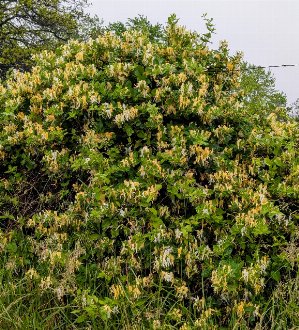Japanese Honeysuckle (Lonicera japonica Thunb.)
↑Summary
A vine native to East Asia and introduced in North America, where it considered invasive, especially in the southeast; can hinder forest regeneration.
↑Habitat
Most invasive in the southeastern U.S., although established on isolated sites as far north as coastal Maine, northern Minnesota, Wisconsin, and Michigan, and also on the West Coast and southwest.
Found mostly in edge habitats, early-successional habitats, and habitats subjected to frequent or recent disturbance, including abandoned fields, woodland borders and thickets, roadsides in forests, forest clearings, and poorly-maintained parks and landscaping in suburban areas. These habitats seem to have in common high-light conditions and an abundance of small-diameter vertical structures to climb. It also utilizes artificial structure, such as chain-link fences.
Most common in moist to mesic conditions and fertile loamy soil. Although it grows most aggressively on rich sites, and will utilize the high nutrients in rich soils, its evergreen nature, and ability to root in a small patch of rich soil and travel quite far to seek sunlight, allows it to compete favorably on sites where soil quality is patchy.
Generally absent from the extremes of the driest or most poorly-drained soils, including coarse sands and nutrient-poor peat soils. Western distribution may be limited by rainfall and moisture availability or may be limited by pollinator availability, and northern distribution is likely limited by the length of the growing season and likelihood of late spring frosts.
Most common in partly shaded habitats with some direct sunlight. Plants can persist, but not fruit, under a closed forest canopy.
Human alteration of the environment has massively favored this species by creating a lot of edge habitat through roads and development, early-succesional habitats through abandonment of agriculture, and artificial structures that it can easily climb.
↑Life Cycle
A perennial woody vine that is usually classified as evergreen, Japanese honeysuckle is intermediate between evergreen and semievergreen in areas with colder winters.
Vegetative reproduction is aggressive. Once established, a vine will spread along the ground in all directions where there is sufficient light and moisture, rooting at nodes and growing taproots at favorable locations, often forming a dense mat with many layers of growth, and stems will climb any available structure, including both trees and shrubs as well as finely-textured human structures like chain-link fences.
Vines can survive in mowed areas, traveling across short stretches of regularly mowed areas to reach new habitats on the other side.
Usually only blooms once it has climbed at least a few feet off the ground, and only when receiving sufficient light. In the absence of enough light to flower, vines can persist under a closed canopy for years, and then climb and flower when light and structure becomes available.
Seeds are distributed to new sites by birds. Most seeds germinate in the spring following dispersal, and this species likely does not form a long-term seed bank. Seedling mortality is high, both due to shade and drought. Seedlings have trouble establishing on sites with heavy competition from grasses and herbaceous plants, as these plants provide competition for ground-level light without providing ideal structure to climb.
Loses some leaves in autumn, leading to somewhat sparser foliage through winter. Except in the harshest conditions, numerous leaves usually persist through winter, more in the southern parts of its range.
Individual plants can live up to 20 years.
↑Faunal Associations
Foliage is eaten by mammalian herbivores, including rabbits and deer. The widespread dominance of this species is probably a large factor in the overpopulation of white-tailed deer, as the foliage is among the softest and most palatable of the evergreen foliage available in most of its range, and it provides a food source at a time when food is usually most scarce for deer.
Fruit are eaten by numerous birds.
↑Control
This plant is relatively easy to reduce in extent and prevent from reproducing by seed, but difficult to completely eliminate from an area. It also is common and widespread in most of the areas where it is invasive, and readily re-colonizes sites where it has been removed, through its bird-dispersed seeds.
A low-effort reduction strategy involves clipping off mature vines at the base, with a pruner or lopping shears. This will kill all attached above-ground vines. Clearing away the bottom few feet of vines as well as any dead branches or other climbable structure can then reduce the chance that the resprouting vines will be able to reach the old structure. Returning every 2-3 years to repeat this strategy will usually prevent this vine from producing fruit on a site, and will minimize its strangling of young woody plants, allowing them to grow large enough that they are no longer able to be climbed by the vines.
A more thorough control strategy involves finding the largest nodes, and uprooting the root systems. Vines can then be clipped into pieces and left in place to dry out and die. By eliminating the more vigorous nodes where the plant has rooted, which tend to be concentrated in fertile, moist, and well-aerated patches of soil, regrowth will be less vigorous. Such an approach will also increase the likelihood that competing, hopefully native vegetation, will colonize the space left by removal of the key nodes. Such an approach makes the most sense on sites where there is already some native ground-level vegetation being suppressed by this species.
In the long-run, searching down and pulling out peripheral runners may be necessary to prevent re-establishment. If the conditions on the site are suitable to seedling establishment, the area must continually be monitored for seedlings or the plant will re-establish itself. A closed forest canopy, and/or dense ground-level growth of grasses and broadleaf herbaceous plants, can hinder seedling establishment. However, re-establishment is most likely to occur from mature, vigorous plants whose root system remains.
This plant can be controlled effectively at any time of year, and root systems can be dug out whenever the ground is not frozen, but it is often most effective to remove this plant in spring, ideally just after it has leafed out. This maximizes the stress and depletion of resources to the root system, and also increases the light levels reaching competing vegetation, as most competing vegetation leafs out slightly later in spring, so such timing can help give competing vegetation an upper hand, including both trees and ground-level growth of grass and herbaceous plants.
↑Uses
The nectar of the flowers is sweet and has a pleasant floral scent, and is edible to humans, although it is consumed mainly as a novelty.
This plant has historically been planted intentionally in the U.S. in attempts to increase deer populations for hunting. It has also been planted as erosion control, and as a landscaping plant, where it is valued for its fragrant flowers.
The widespread planting of this plant was probably a major factor in its widespread establishment in North America.
↑Related Plants
Numerous other Lonicera species, both native and introduced, are found throughout North America, including in the range where this species is established. No hybrids with this species have been reported.
↑Notes
This plant can hinder forest regeneration by smothering trees and shrubs. It spreads along edge habitats created by humans and then colonizes abandoned fields where it slows and alters the natural succession from field into forest. This effect synergizes with overpopulation of white-tailed deer, which also thrive in edge habitats, and are directly supported by this species, and also have a similar effect on hindering regeneration of native trees through browsing.
↑Links & External Resources
• Japanese Honeysuckle | Fire Effects Information System (FEIS) (About This Site)
• Lonicera japonica (Japanese Honeysuckle) | Illinois Wildflowers (About This Site)
• Lonicera japonica (Japanese Honeysuckle) | USDA PLANTS Database (About This Site)
• Lonicera japonica | Go Botany (About This Site)
• Japanese Honeysuckle | Virginia Tech Dendrology Factsheets (About This Site)
• Lonicera japonica | Biota of North America Project (BONAP) (About This Site)
• Lonicera japonica | NatureServe Explorer (About This Site)
• Lonicera japonica | Missouri Plants (About This Site)
• Japanese Honeysuckle | Maryland Biodiversity Project (About This Site)
• Lonicera japonica Thunb. (Japanese Honeysuckle) | Digital Atlas of the Virginia Flora (About This Site)







